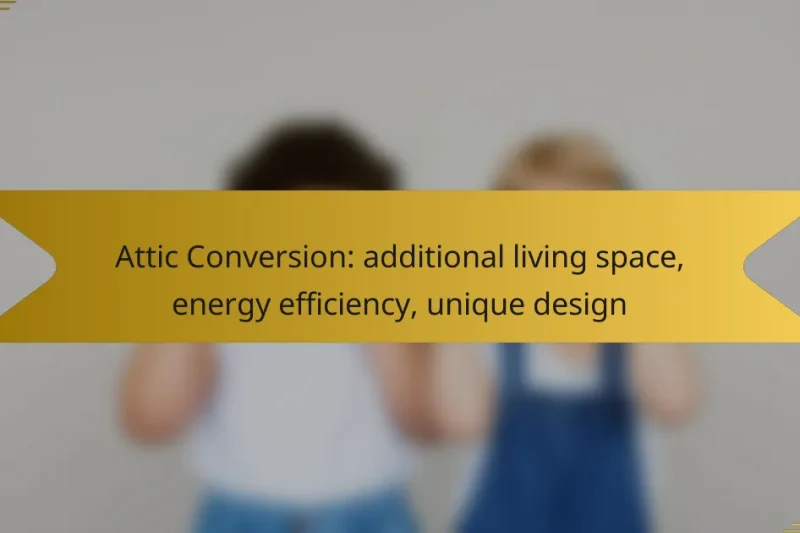Finishing a basement is an effective way to transform an underutilized area into valuable living space, … Basement Finishing: additional living space, increased property value, versatile usageRead more
Reasons to Consider Home Renovations
Home renovations can significantly improve living conditions and increase property value, particularly in urban areas where space is limited and property costs are high. Upgrading key areas such as the kitchen and bathroom not only enhances aesthetics and functionality but also transforms everyday experiences into enjoyable moments, making these renovations a smart investment for homeowners.
Attic Conversion: additional living space, energy efficiency, unique design
Converting an attic into livable space can dramatically increase your home’s functionality and appeal, turning an … Attic Conversion: additional living space, energy efficiency, unique designRead more
Kitchen Remodel: increased functionality, modern design, enhanced value
A kitchen remodel is an excellent way to boost both functionality and aesthetic appeal, creating a … Kitchen Remodel: increased functionality, modern design, enhanced valueRead more
Living Room Update: open concept design, upgraded materials, improved lighting
Transforming your living room with an open concept design fosters a spacious and inviting atmosphere, seamlessly … Living Room Update: open concept design, upgraded materials, improved lightingRead more
Why should homeowners consider renovations in urban areas?
Homeowners in urban areas should consider renovations to enhance their living conditions and increase property value. Urban settings often face unique challenges, such as limited space and higher property costs, making thoughtful renovations a strategic investment.
Increased property value
Renovating a home in an urban area can significantly boost its market value. Upgrades such as modern kitchens, updated bathrooms, and additional living space can attract potential buyers and justify higher asking prices.
Consider focusing on renovations that are popular in your neighborhood. For instance, adding a deck or finishing a basement can yield returns of 70% to 80% on investment, depending on local market trends.
Enhanced living space
Urban homes often have limited square footage, making efficient use of space essential. Renovations like open floor plans or multi-functional rooms can create a more spacious feel and improve daily living.
Think about incorporating built-in storage solutions or converting underutilized areas, such as attics or basements, into usable living space. These changes can make a home more comfortable and functional for families or individuals.
Improved energy efficiency
Renovations can also enhance a home’s energy efficiency, which is particularly beneficial in urban areas where utility costs can be high. Upgrading insulation, windows, and HVAC systems can lead to significant savings on energy bills.
Investing in energy-efficient appliances and smart home technology can further reduce consumption. Many local governments offer incentives or rebates for energy-efficient upgrades, making them an attractive option for homeowners looking to save money in the long run.
What are the benefits of kitchen renovations?
Kitchen renovations offer numerous advantages, including improved aesthetics, enhanced functionality, and increased property value. By updating your kitchen, you can create a more enjoyable cooking and dining experience while also making a smart investment in your home.
Modernized appliances
Upgrading to modern appliances can significantly enhance your kitchen’s efficiency and convenience. Energy-efficient models often consume less electricity and water, leading to lower utility bills over time. Consider appliances with smart technology that can be controlled remotely or provide energy usage data.
When selecting new appliances, look for those with high energy ratings, as they can save you money in the long run. Brands often offer rebates for energy-efficient purchases, making this an even more attractive option.
Better functionality
Renovating your kitchen can improve its layout and functionality, making meal preparation and entertaining easier. Consider an open-concept design that allows for better flow between the kitchen and dining areas. Adding an island can provide additional counter space and storage.
Evaluate your current kitchen workflow and identify pain points. For example, if you often find yourself running out of storage, incorporating cabinets that reach the ceiling or pull-out shelves can maximize space.
Increased home value
A well-executed kitchen renovation can significantly boost your home’s market value. Potential buyers often prioritize updated kitchens, making your property more appealing. According to real estate experts, a kitchen remodel can yield a return on investment of around 60-80% when you sell your home.
To maximize value, focus on mid-range updates rather than high-end luxury finishes, which may not recoup their costs. Simple updates like new countertops, fresh paint, and modern fixtures can make a big difference without breaking the bank.
How do bathroom renovations impact home comfort?
Bathroom renovations significantly enhance home comfort by improving functionality, aesthetics, and overall ambiance. A well-designed bathroom can transform daily routines into enjoyable experiences, making it a crucial area for upgrades.
Improved aesthetics
Renovating a bathroom can dramatically elevate its visual appeal. By selecting modern fixtures, stylish tiles, and cohesive color schemes, homeowners can create a space that feels inviting and luxurious. This aesthetic upgrade not only enhances personal enjoyment but can also increase the home’s market value.
Consider incorporating elements like a freestanding tub or a walk-in shower to create a focal point. Simple changes, such as new lighting or updated cabinetry, can also refresh the look without extensive renovations.
Enhanced relaxation
A renovated bathroom can serve as a personal retreat, promoting relaxation and stress relief. Features such as soaking tubs, rainfall showerheads, and heated floors can transform the space into a spa-like environment. These enhancements encourage longer, more enjoyable bathing experiences.
To maximize relaxation, consider adding calming colors and natural materials. Incorporating plants or soft lighting can further enhance the tranquil atmosphere, making the bathroom a perfect escape from daily stressors.
Increased safety features
Bathroom renovations can significantly improve safety, especially for families with children or elderly members. Installing grab bars, non-slip flooring, and proper lighting can help prevent accidents and create a more secure environment. These features are essential for maintaining independence and comfort in the home.
When planning renovations, ensure that all fixtures meet local building codes and safety standards. Prioritize accessibility by considering walk-in tubs or curbless showers, which can greatly benefit those with mobility challenges.
What are the financial considerations for home renovations?
Financial considerations for home renovations include budgeting, financing options, and potential returns on investment. Understanding these aspects helps homeowners make informed decisions about their renovation projects.
Budgeting for renovations
Creating a budget for renovations is essential to avoid overspending. Start by determining the overall amount you can allocate, including materials, labor, and unexpected costs, which can often add 10-20% to the initial estimate.
Break down the budget into categories such as structural changes, aesthetic upgrades, and permits. This detailed approach allows for better tracking of expenses and helps prioritize which renovations are most important.
Financing options available
Homeowners have several financing options for renovations, including personal loans, home equity lines of credit (HELOC), and refinancing existing mortgages. Each option has its pros and cons, such as interest rates, repayment terms, and accessibility.
For instance, a HELOC typically offers lower interest rates compared to personal loans, but it requires sufficient equity in your home. Evaluate your financial situation and choose the option that aligns with your budget and repayment capability.
Return on investment analysis
Analyzing the return on investment (ROI) for renovations helps determine which projects are worth pursuing. Generally, kitchen and bathroom remodels tend to yield higher returns, often recouping 70-80% of costs upon resale.
Consider local market trends when evaluating potential ROI. Research comparable homes in your area to see which renovations have increased their value. This information can guide your decisions and ensure your investments align with market demands.
How do renovations improve energy efficiency?
Renovations can significantly enhance a home’s energy efficiency by upgrading key components that reduce energy consumption. This not only lowers utility bills but also contributes to a more sustainable living environment.
Upgrading insulation
Improving insulation is a fundamental step in enhancing energy efficiency. Proper insulation helps maintain a consistent indoor temperature, reducing the need for heating and cooling systems to work overtime. Consider using materials with high R-values, which indicate better thermal resistance.
Common insulation options include fiberglass batts, spray foam, and cellulose. Each has its benefits and costs, so evaluate your specific needs and local climate when choosing the right type.
Installing energy-efficient windows
Energy-efficient windows are designed to minimize heat transfer, keeping homes warmer in winter and cooler in summer. Look for windows with low U-factors and high Solar Heat Gain Coefficient (SHGC) ratings to ensure optimal performance.
Double or triple glazing, along with low-emissivity (Low-E) coatings, can significantly reduce energy loss. While the initial investment may be higher, the long-term savings on energy bills often justify the expense.
Utilizing smart home technology
Smart home technology can optimize energy use by allowing homeowners to monitor and control their energy consumption. Devices such as smart thermostats, lighting systems, and energy monitors can lead to substantial savings.
For instance, a smart thermostat can learn your schedule and adjust heating and cooling accordingly, potentially reducing energy costs by 10-15%. When integrating smart technology, ensure compatibility with existing systems for seamless operation.
What are the latest trends in home renovations?
Current trends in home renovations focus on sustainability, open layouts, and smart technology. Homeowners are increasingly looking to create spaces that are both functional and environmentally friendly, while also integrating modern conveniences.
Sustainable materials
Sustainable materials are becoming a priority in home renovations as homeowners seek to reduce their environmental impact. Options like bamboo flooring, recycled glass countertops, and reclaimed wood not only minimize waste but also add unique character to spaces.
When selecting sustainable materials, consider certifications such as FSC (Forest Stewardship Council) for wood products or LEED (Leadership in Energy and Environmental Design) for overall project sustainability. These certifications ensure that materials are sourced responsibly and meet environmental standards.
Open floor plans
Open floor plans continue to gain popularity as they create a sense of spaciousness and improve flow between living areas. By removing walls between the kitchen, dining, and living rooms, homeowners can foster a more social environment that is ideal for entertaining.
However, it’s essential to consider the structural implications of removing walls. Consulting with a professional to ensure that load-bearing walls are properly managed is crucial to maintain the integrity of the home.
Smart home integrations
Smart home integrations are transforming how homeowners interact with their living spaces. Features like smart thermostats, lighting systems, and security cameras can enhance convenience, energy efficiency, and safety.
When incorporating smart technology, prioritize systems that are compatible with each other to create a cohesive network. Look for user-friendly interfaces and consider the long-term costs of maintenance and upgrades to ensure a worthwhile investment.



